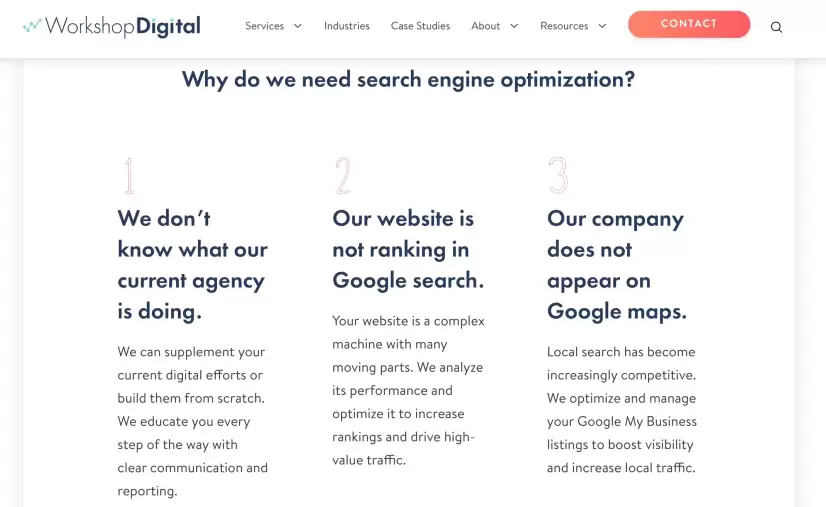If you’re a frequent visitor to our website, you may notice that things look a little different. You’re right. We recently redesigned our website—and we’re pretty proud of the results. (If you’re a first-time visitor, welcome! Stay a little while. Poke around.)
If you’ve ever been involved in a full-scale website build (or rebuild), you know that there are many moving parts that must fall into place before launch. From UX and design, to development and testing, there’s a lot that’s behind a successful website redesign. It’s a time-consuming process.
Let’s discuss how content writing fits into a website launch.
And how design and SEO help inform the writing process.
Writing copy for an entire website is no easy task. Whereas writing ads and other short-form copy benefits from iteration and testing, web content demands additional oversight and organization (and then iteration and testing…). It requires writers to employ storytelling tactics across numerous pages. Plus, this multilayered approach must be optimized for the search engines.
Your website is the first thing that many of your prospects interact with. So, it’s essential to tell a cohesive brand story across your entire site. This means that writers must connect the dots between disparate pages—from service and product to about and contact pages.
This is no small task. But it can be done. Let’s review five steps that help guide the process.
1. Establish Your Website Goals
Before you get started with any actual writing, it’s important to set your goals. This means aligning expectations with all stakeholders. Asking questions can help everyone get on the same page:
- Why are you redesigning your website in the first place?
- What isn’t working for your current site?
- What are your new requirements?
- What are you hoping to achieve with your new product?
- What does a finished project look like?
At Workshop Digital, our stakeholders were varied and involved members of multiple teams. Our goals were to build a website that drove lead generation and conveyed our industry expertise. We wanted a scalable, sophisticated design that engaged our target audiences. And we wanted to increase our conversion opportunities across the website.
By establishing our goals from the onset, we were able to set appropriate benchmarks and timelines. Aligning our expectations meant we were on the same page for the remainder of the project.
2. Audit & Analyze Current Content
A website relaunch is the perfect time to assess and analyze existing content. Take a look at all your content—including every web page, blog post, and landing page you’ve ever created. While performing a content audit may seem like a tedious task, it’s a necessary one.
An audit gauges the quality of current content and proves it’s accurate and topical. It helps ensure that what you port over to your new site embodies your current brand voice—and that it supports current goals. When we performed our audit, we uncovered content that either discussed outdated products and trends or just didn’t resonate with our current brand.
Our SEO and marketing teams broke the content audit into four categories:
- Keep: Luckily, a good chunk of our content was strong enough to transfer over in its current form.
- Modify: In other cases, content on the old website didn’t match the structure of the new website, or was simply outdated. In both cases, we updated it before transferring.
- Remove: Historical performance data from Google Analytics and Google Search Console helped us decide which content needed to be removed. Pruning content helped expunge underperforming content, while maximizing the potential of successful pieces.
- Create: Once we determined what needed to be created, we performed keyword research to help with rankings and thoughtfully integrated it into the new site structure.
As our SEO Analyst recently wrote, involving SEO at the early stages of a website launch helps confirm that all titles, meta descriptions, and noindex tags are implemented properly. It also helps you confirm that the titles, headings, and metadata for old content are in place. Finally, an audit uncovers whether end users are engaging with your content or not—which can help inform your future content strategy.
3. Wireframe & Brainstorm
Much like a creative brief guides a copywriter through a campaign's concept and strategy phases, wireframes serve as a roadmap for web projects. A wireframe is a visual mockup that demonstrates the structure of a forthcoming webpage. It outlines what elements—including headers, body copy, sign up forms, and calls-to-action—will live on each page.
In our case, wireframes were presented by the talented design team at FosterMade in the form of an in-person brainstorm session. Equipped with large poster board and a set of multicolored markers, FosterMade instructed us to physically mockup web pages with our preferred order of design elements. This exercise allowed us to get a tangible feel for the site. And it helped me walk away with a clear idea of content organization and prioritization.
4. Sit Down & Write
At a certain point, you just have to start writing. This is the time to do so.
Writing for the web is a fickle process. Unlike other campaign-oriented content—including ad copy, blogs, and ebooks—your audience may not be as clearly defined. For example, at Workshop Digital, we work in a variety of industries, all of which have their inherent challenges. We knew it was essential to keep the content of our website general enough, while still addressing specific challenges. This paradox underlies one of the primary challenges of writing for the web.
It’s essential to write for a wide audience.
Keep things short and sweet—including your headers and supporting paragraphs. Simple content is digestible and can be scanned and skimmed by readers. Keeping jargon and technical terminology to a minimum also helps extend your reach.
In our case, we knew that we wanted to clearly communicate our services and differentiators. Perhaps most importantly, we wanted to address audience pain points and industry-specific buyer personas. To account for this, we included a selection of FAQs on each service page (see below for a quick example) and optimized these questions to reflect actual inquiries we may hear from prospects.

5. Refine & Align
After you’ve written thousands of words (and in my case, organized them across a Google Doc), it’s the time to review, refine, and align your efforts across your entire team. Use your initial goals as a benchmark:
- Are you accomplishing all your predetermined objectives?
- Are you embodying your new and improved brand identity across your copy?
- And are you catering to the needs of your personas?
Optimize web copy so it’s discoverable by search engines and users.
This is also the time to bridge the gap between creativity and strategy. Working together with our SEO Analyst, I was able to target relevant keyword and keyword phrases across header and body copy. While SEO research certainly informs copy, I personally find it helpful to incorporate these findings during the review process. That way, I can check that my story is being told—and augment my copy with SEO-friendly terminology in a natural way that places emphasis on important sections.
Writing SEO-friendly content for the web should be no different than other mediums. As we’ve discussed, page quality is influenced by expertise, authority, and trustworthiness. This means that your web copy must be easy to find and understand. Effective SEO research helps uncover what your end users are searching for. And concise, comprehensible copy helps readers understand what you’re discussing.
Do you have any web content writing techniques? How do you organize a large project into digestible tasks? Finally, how do you bridge the gap between SEO and copywriting?

